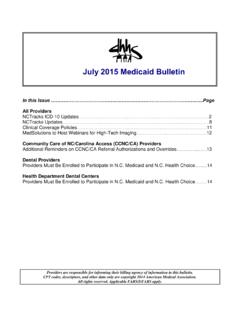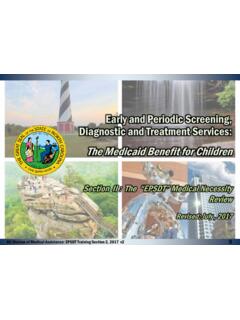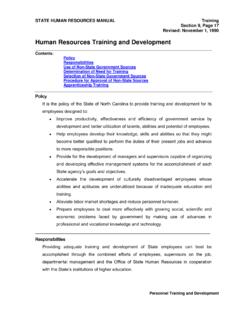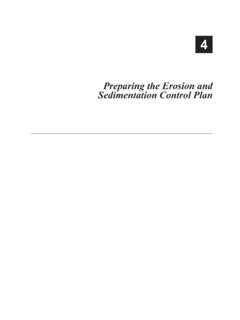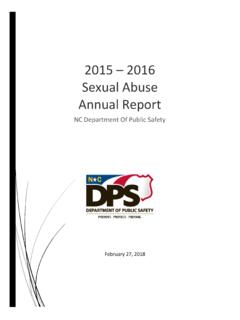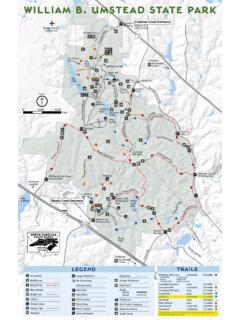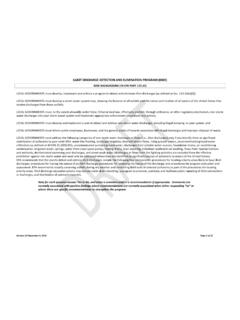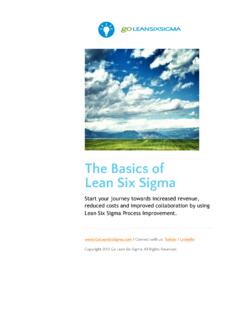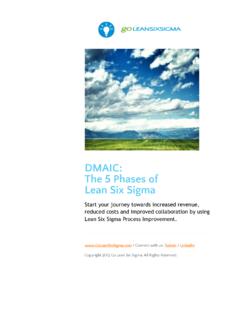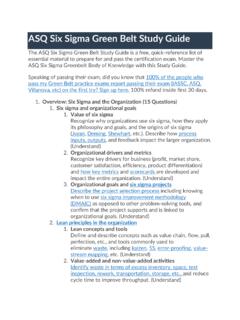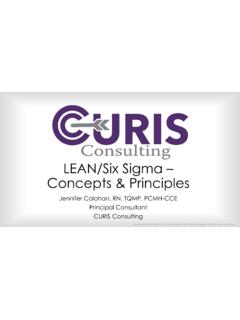Transcription of Lean Basics Overview - NC
1 1 Copyright 2010 EMC Corporation. All rights Basics Overview EMC 2011 TrainingNCDENR April 20112 Copyright 2010 EMC Corporation. All rights Lean Six sigma defined Why Lean Six sigma ? What s a process? Interrogating the process by identifying Value & Waste Brief Overview of some tools that identify Waste Key principles of Lean Thinking: Flow & Pull Brief Overview of some tools that help eliminate Waste Next steps 3 Copyright 2010 EMC Corporation. All rights Process improvement methodologytargeting the elimination of waste any human activity that absorbs resources but creates no value. Lean Thinkingis the method used to combat waste Pioneered by the Toyotacompany in Japan after WWII.
2 Application of Lean in Manufacturing has led to much cost removal via the elimination of wasteful efforts. Lean Thinking provides for change that allows you to do more with less while coming closer to providing customers with what they really want. Lean concepts can easily be used in other business applications and is not just beneficial to manufacturing4 Copyright 2010 EMC Corporation. All rights what is LEAN?Simplify the process Identification of value and elimination of waste to improve the process. Key Lean Performance Goals On-demand: when the customer wants it Defect-free: how the customer wants it One-by-one: exactly the quantity the customer wants Lowest total cost: business cost for you and the customerKey Principles of Lean Thinking Value: what customers are willing to pay for Value Stream: all the steps in our processes that deliver value to our customers Flow: organizing the Value Stream to be continuous Pull: responding to downstream customer demand Perfection: relentless continuous improvementculture; A continuous journey 5 Copyright 2010 EMC Corporation.
3 All rights sigma Business management strategy developed by Motorola in the 1980 s. Seeks to improve the quality of processes by identifying and removing causes of defects and minimizing variabilitywithin in process. Six sigma is a statistical term indicating a high level of quality of the products are expected to be free of defects Can also be stated as defects per million Six sigma tools and concepts can easily be used in other business applications and is not just beneficial to Copyright 2010 EMC Corporation. All rights is Six sigma ?Level of Process Performance Defects per Million OpportunitiesPhilosophy Executive Ownership Business Profitability & Customer Satisfaction Moving the Mean Variation Reduction Data-based decisions Hard, Soft and Strategic Benefits Consistent, Rigorous Approach to Problem Solving Define Measure Analyze Improve ControlThe right people working a well scoped problemClearly understand and measure the As Is ProcessAnalyze failure modes to understand the causes and effectsExperiment with and improve process based on dataMonitor critical outputs to prevent repeat failure7 Copyright 2010 EMC Corporation.
4 All rights Lean Six sigma ?Drives down costs by eliminating waste and process variabilityN (Simplify)NE (Simplify & Control)E (Control)LeanSix Sigma8 Copyright 2010 EMC Corporation. All rights reserved. A structured problem solving methodology used to: Define (Scope) Get the right people on a well scoped problem Set a SMART goal on what s critical to the customer SMART? Specific, Measurable, Achievable, Relevant, Time-bound Measure (Baseline) As Is process around the problem Data, variation not just the average Analyze (Cause &Effect) Drives cause and effect conversations around the As Is process Look for variation in the critical metric throughout the process Look for waste with Lean tools Prioritizes where to workLean Six sigma .
5 Combines the strengths of both approaches9 Copyright 2010 EMC Corporation. All rights Six sigma ..combines the strengths of both approaches Structured problem solving methodology continued: Improve (Communication) Improves the process based on waste removal and mistake proofing Improves the process based on data Control (Control Plan) Develop a control plan to maintain the gains and have an early warning system on the critical metric10 Copyright 2010 EMC Corporation. All rights does Lean Six sigma help us compete? Profit=Price Cost Price controlled bymarket Cost controlled by theseller Greatest competitive edge is cost reduction Reduce cost by Waste elimination those things customers do not want or need Reduce cost and improve quality by removing Variability Increase customer satisfaction at lower costs by: identifying their needs (values) eliminating process variation providing what the customer needs when they need it 11 Copyright 2010 EMC Corporation.
6 All rights questions about Lean, Six sigma , or Lean Six sigma ?12 Copyright 2010 EMC Corporation. All rights improvement requires that we know our process ..what s a process? A set of common tasks that creates a product, service, or plan that will satisfy a customer or group of customers. Processes can have internal customers and external customers A sequential series of steps leading to a desired outcome If you can't describe what you are doing as a process, you don't know what you're Edwards Deming13 Copyright 2010 EMC Corporation. All rights s a great tool that we can use to get an Overview of a process in just 1 page?
7 Process (Activity) NameProcessInput*Output** Input and Output Variables that are MeasurableInputInputInputInputInputInput OutputOutputOutputOutputOutputOutputIPO Chart14 Copyright 2010 EMC Corporation. All rights questions about what s a process? IPOs? 15 Copyright 2010 EMC Corporation. All rights the process Where s the Value? Where s the Waste?16 Copyright 2010 EMC Corporation. All rights reserved. Value Add Customer believes it is important; willing to pay for this task Physically changes the thing adding desired function, form, or feature Work is done right the first time Non-Value Add Task adds no value as viewed by the customer Examples include: correcting/reworking, expediting, multiple signatures, counting, handling, inspecting, set up time, downtime, transporting, moving, delaying, Necessary Non Value Add Process would break down if this task was not performed Required by law or regulation Task reduces financial riskValue 17 Copyright 2010 EMC Corporation.
8 All rights About Seeing Waste WASTEisn t a judgment on how well people work; it exists in all processes Processes are wasteful, people are not Don t take it personally; let s improve the processes Our solutions have to eliminate waste Waste elimination improves performance Improved performance creates secure companies Secure companies create secure Jobs As we learn to see waste, we need to work on not being judgmental about itIt is what it and it wasn't created intentionally18 Copyright 2010 EMC Corporation. All rights :Physical movement of materials or work from where it was produced to where it is neededDefining Value Seeing the Waste19 Copyright 2010 EMC Corporation. All rights :Any excess material within a processthat the customer does not want or need based on actual demandDefining Value Seeing the Waste20 Copyright 2010 EMC Corporation.
9 All rights without productivity:If motion is part of the process and not used to add value, it is wasteDefining Value Seeing the Waste21 Copyright 2010 EMC Corporation. All rights :People or parts that waitfor a work cycle to be completedDefining Value Seeing the Waste22 Copyright 2010 EMC Corporation. All rights :Producing items for which there are no true customer orders or more work than the next operation needs or can absorbDefining Value Seeing the Waste23 Copyright 2010 EMC Corporation. All rights :Any non-value added activitythat customers neither want,request or will pay Value Seeing the Waste24 Copyright 2010 EMC Corporation. All rights :A defect is a component or unit which the customer would deem unacceptable Defining Value Seeing the Waste25 Copyright 2010 EMC Corporation.
10 All rights Risks are a WasteSafety risks are in processes that enable injuries to happen in the cost through: lost work days higher insurance costs product delivery delays slowing the process Defining Value Seeing the Waste26 Copyright 2010 EMC Corporation. All rights Forms of Waste(TIMWOODS)Defining Value Seeing the WasteWasteCategoryProductionExampleAdmin istrationExampleTransportationExcessesMo ving material between disjointed production stages in separate locationsWalking around to get approval signatures on a travel authorizationInventoryBuild-upLarge WIP (work in progress) inventory during production stagesMultiple copies of a document stored in every deskMotionWithoutProductivityOperator must bend over to pick up circuit board to start production sequenceLooking for poorly filed documents by searching every filing cabinetWaitingforMaterialsWaiting for raw material replenishment to begin production setupWaiting for approval signature of a documentOverProductionProducing more than production schedule requirementsGenerating project status reports that are not reviewed or usedOverProcessingReworking of defective components from the first stage of productionCapital projects plans needing reviews and signatures from 18 peopleDefectsProducing one bad unit

